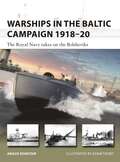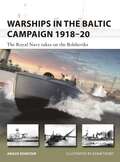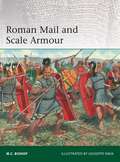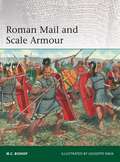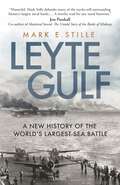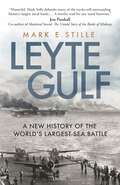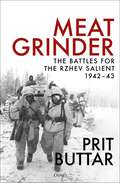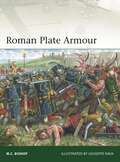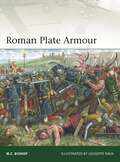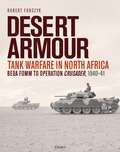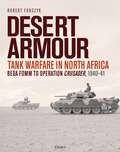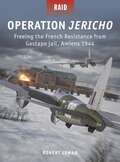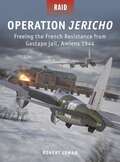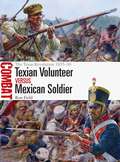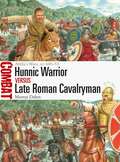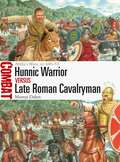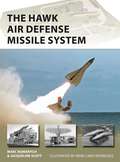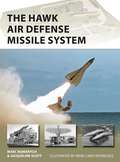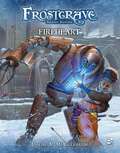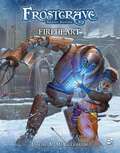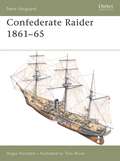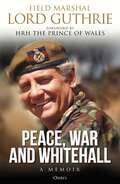- Table View
- List View
Warships in the Baltic Campaign 1918–20: The Royal Navy takes on the Bolsheviks (New Vanguard)
by Angus KonstamA fascinating look at the British naval intervention in the Baltic in 1918–20, and at the British, Soviet and Baltic nationalist fleets that fought.Following the Russian Revolution of October 1917, the Baltic states became a battleground between Russian Reds and Whites, German troops and emerging Baltic independence forces. In November 1918, the British government decided to intervene, to protect British interests and to support the emerging Baltic states. This initial small force of cruisers and destroyers was eventually augmented by other British warships, including aircraft carriers, a monitor, as well as a handful of submarines and torpedo boats. Opposing them was the far more powerful Russian Baltic Fleet, now controlled by the Bolsheviks. The campaign that followed involved naval clashes between the two sides, the most spectacular of which was an attack on the Soviet naval base of Kronstadt in June 1919 by a force of small British torpedo boats. They torpedoed and sunk the Russian cruiser Oleg, an action which effectively bottled the Baltic fleet up in port for the remainder of the campaign. Finally, in early 1920, the British squadron was withdrawn, following Soviet recognition of Estonia, Latvia and Lithuania. This New Vanguard title explores the naval side of this little-known but strategically crucial campaign fought by the war-weary navies of Britain and Russia and by warships of the emerging Baltic states. Describing the political background to the conflict, and the key points of the naval campaign as well as the warships involved, this is a concise and fascinating account of an overlooked naval campaign that helped reshape the map of Europe.
Warships in the Baltic Campaign 1918–20: The Royal Navy takes on the Bolsheviks (New Vanguard)
by Angus KonstamA fascinating look at the British naval intervention in the Baltic in 1918–20, and at the British, Soviet and Baltic nationalist fleets that fought.Following the Russian Revolution of October 1917, the Baltic states became a battleground between Russian Reds and Whites, German troops and emerging Baltic independence forces. In November 1918, the British government decided to intervene, to protect British interests and to support the emerging Baltic states. This initial small force of cruisers and destroyers was eventually augmented by other British warships, including aircraft carriers, a monitor, as well as a handful of submarines and torpedo boats. Opposing them was the far more powerful Russian Baltic Fleet, now controlled by the Bolsheviks. The campaign that followed involved naval clashes between the two sides, the most spectacular of which was an attack on the Soviet naval base of Kronstadt in June 1919 by a force of small British torpedo boats. They torpedoed and sunk the Russian cruiser Oleg, an action which effectively bottled the Baltic fleet up in port for the remainder of the campaign. Finally, in early 1920, the British squadron was withdrawn, following Soviet recognition of Estonia, Latvia and Lithuania. This New Vanguard title explores the naval side of this little-known but strategically crucial campaign fought by the war-weary navies of Britain and Russia and by warships of the emerging Baltic states. Describing the political background to the conflict, and the key points of the naval campaign as well as the warships involved, this is a concise and fascinating account of an overlooked naval campaign that helped reshape the map of Europe.
Roman Mail and Scale Armour (Elite #252)
by M.C. BishopFully illustrated, this study investigates the origins, evolution and use of the mail and scale armour worn by the soldiers and gladiators of Imperial Rome.Less glamorous than the Roman Army's instantly recognizable plate armour but much more versatile, mail and scale armour were used by both legionaries and auxiliaries throughout Rome's history. Developed by the Celts and quickly adopted by the Romans, mail armour was easy to make and required little maintenance. Scale was a much older form of armour, originating in the Near East during the second millennium BC. As with mail, it was used by both auxiliaries and legionaries, but like plate armour, it was much more fragile than mail. Both types of armour were also used by gladiators (principally as arm defences).New discoveries in both mail and scale, as well as in hybrid forms that mixed the two, mean that much more is now known about the development of these types of defence during the Roman period, their efficacy in battle and how they were manufactured and repaired. Featuring specially commissioned artwork and drawing upon the latest findings, this study lifts the veil on the mail and scale armour used by soldiers, gladiators and others during the heyday of Imperial Rome.
Roman Mail and Scale Armour (Elite #252)
by M.C. BishopFully illustrated, this study investigates the origins, evolution and use of the mail and scale armour worn by the soldiers and gladiators of Imperial Rome.Less glamorous than the Roman Army's instantly recognizable plate armour but much more versatile, mail and scale armour were used by both legionaries and auxiliaries throughout Rome's history. Developed by the Celts and quickly adopted by the Romans, mail armour was easy to make and required little maintenance. Scale was a much older form of armour, originating in the Near East during the second millennium BC. As with mail, it was used by both auxiliaries and legionaries, but like plate armour, it was much more fragile than mail. Both types of armour were also used by gladiators (principally as arm defences).New discoveries in both mail and scale, as well as in hybrid forms that mixed the two, mean that much more is now known about the development of these types of defence during the Roman period, their efficacy in battle and how they were manufactured and repaired. Featuring specially commissioned artwork and drawing upon the latest findings, this study lifts the veil on the mail and scale armour used by soldiers, gladiators and others during the heyday of Imperial Rome.
Leyte Gulf: A New History of the World's Largest Sea Battle
by Mark StilleA fascinating re-examination of the battle of Leyte Gulf, the largest naval encounter in history and probably the most decisive naval battle of the entire Pacific War, and one that saw the Imperial Japanese Navy eliminated as an effective fighting force and forced to resort to suicide tactics.Leyte was a huge and complex action, actually consisting of four major battles, each of which are broken down in detail in this book, using original sources. The plans of both sides, and how they dictated the events that followed, are also examined critically.So much of the accepted wisdom of the battle has developed from the many myths that surround it, myths that have become more firmly established over time. In this new study, Pacific War expert Mark Stille examines the key aspects of this complex battle with new and insightful analysis and dismantles the myths surrounding the respective actions and overall performances of the two most important commanders in the battle, and the “lost victory” of the Japanese advance into Leyte Gulf that never happened.
Leyte Gulf: A New History of the World's Largest Sea Battle
by Mark StilleA fascinating re-examination of the battle of Leyte Gulf, the largest naval encounter in history and probably the most decisive naval battle of the entire Pacific War, and one that saw the Imperial Japanese Navy eliminated as an effective fighting force and forced to resort to suicide tactics.Leyte was a huge and complex action, actually consisting of four major battles, each of which are broken down in detail in this book, using original sources. The plans of both sides, and how they dictated the events that followed, are also examined critically.So much of the accepted wisdom of the battle has developed from the many myths that surround it, myths that have become more firmly established over time. In this new study, Pacific War expert Mark Stille examines the key aspects of this complex battle with new and insightful analysis and dismantles the myths surrounding the respective actions and overall performances of the two most important commanders in the battle, and the “lost victory” of the Japanese advance into Leyte Gulf that never happened.
Meat Grinder: The Battles for the Rzhev Salient, 1942–43
by Prit ButtarAn engrossing history of the desperate battles for the Rzhev Salient, a forgotten story brought to life by the harrowing memoirs of German and Russian soldiers.The fighting between the German and Russian armies in the Rzhev Salient during World War II was so grisly, so murderous, and saw such vast losses that the troops called the campaign 'The Meat Grinder'. Though millions of men would fight and die there, the Rzhev Salient does not have the name recognition of Leningrad or Moscow. It was simply a vast tract of forests and swamps in the heart of Mother Russia that has been largely ignored by Western historians…until now. Prit Buttar, a world expert on the Eastern Front during World War II, reveals the depth and depravity of the bitter fighting for the Rzhev Salient in this astonishing new history. He details how the long-ignored region held the promise of a renewed drive on the Soviet capital for the German Army – a chance to turn the tide of war. Using both German and Russian first-hand accounts, Buttar examines the four major offensives launched by the Red Army against the salient, all of which were defeated with heavy losses, exceeding two million killed, wounded or missing, until eventually, the Germans were forced to evacuate the salient in March 1943.Drawing on the latest research, Meat Grinder provides a new study of these horrific battles but also examines how the Red Army did ultimately learn from its colossal failures and how its analysis of these failures at the time helped pave the way for the eventual Soviet victory against Army Group Centre in the summer of 1944, leaving the road to Berlin clear.
Meat Grinder: The Battles for the Rzhev Salient, 1942–43
by Prit ButtarAn engrossing history of the desperate battles for the Rzhev Salient, a forgotten story brought to life by the harrowing memoirs of German and Russian soldiers.The fighting between the German and Russian armies in the Rzhev Salient during World War II was so grisly, so murderous, and saw such vast losses that the troops called the campaign 'The Meat Grinder'. Though millions of men would fight and die there, the Rzhev Salient does not have the name recognition of Leningrad or Moscow. It was simply a vast tract of forests and swamps in the heart of Mother Russia that has been largely ignored by Western historians…until now. Prit Buttar, a world expert on the Eastern Front during World War II, reveals the depth and depravity of the bitter fighting for the Rzhev Salient in this astonishing new history. He details how the long-ignored region held the promise of a renewed drive on the Soviet capital for the German Army – a chance to turn the tide of war. Using both German and Russian first-hand accounts, Buttar examines the four major offensives launched by the Red Army against the salient, all of which were defeated with heavy losses, exceeding two million killed, wounded or missing, until eventually, the Germans were forced to evacuate the salient in March 1943.Drawing on the latest research, Meat Grinder provides a new study of these horrific battles but also examines how the Red Army did ultimately learn from its colossal failures and how its analysis of these failures at the time helped pave the way for the eventual Soviet victory against Army Group Centre in the summer of 1944, leaving the road to Berlin clear.
Roman Plate Armour (Elite)
by M.C. BishopFully illustrated, this book investigates the articulated plate armour worn by Roman legionaries.First named by Renaissance historians studying the reliefs on Trajan's Column, lorica segmentata evaded successful attempts to reconstruct it until a series of important archaeological finds in the 20th century revealed how it worked and the truth of its extended chronology. The earliest finds date from the late 1st century BC, and its discovery at Kalkriese in Germany shows how rapidly it was adopted. At the same time, discoveries in Spain and Britain showed that, despite its apparent fragility, it continued in use into the 4th century AD.The spectacular find of six halves of cuirasses in a chest at Corbridge in 1964 has now been matched by the rare discovery of a complete set of this armour at Kalkriese. The Corbridge find provided the context to interpret and reconstruct earlier finds. There is now years of experience gleaned from reenactors over the practical strengths and weaknesses of this form of armour. At the same time, scientific analysis has provided insights into the technology behind this revolutionary form of armour so characteristic of the Roman Army. Featuring specially commissioned artwork and drawing upon the latest findings, this study lifts the veil on the formidable plate armour used by the legionaries of Imperial Rome.
Roman Plate Armour: A Handbook Of Roman Plate Armour (Elite #247)
by M.C. BishopFully illustrated, this book investigates the articulated plate armour worn by Roman legionaries.First named by Renaissance historians studying the reliefs on Trajan's Column, lorica segmentata evaded successful attempts to reconstruct it until a series of important archaeological finds in the 20th century revealed how it worked and the truth of its extended chronology. The earliest finds date from the late 1st century BC, and its discovery at Kalkriese in Germany shows how rapidly it was adopted. At the same time, discoveries in Spain and Britain showed that, despite its apparent fragility, it continued in use into the 4th century AD.The spectacular find of six halves of cuirasses in a chest at Corbridge in 1964 has now been matched by the rare discovery of a complete set of this armour at Kalkriese. The Corbridge find provided the context to interpret and reconstruct earlier finds. There is now years of experience gleaned from reenactors over the practical strengths and weaknesses of this form of armour. At the same time, scientific analysis has provided insights into the technology behind this revolutionary form of armour so characteristic of the Roman Army. Featuring specially commissioned artwork and drawing upon the latest findings, this study lifts the veil on the formidable plate armour used by the legionaries of Imperial Rome.
Desert Armour: Tank Warfare in North Africa: Beda Fomm to Operation Crusader, 1940–41
by Robert ForczykRobert Forczyk covers the development of armoured warfare in North Africa from the earliest Anglo-Italian engagements in 1940 to the British victory over the German Afrikakorps in Operation Crusader in 1941. The war in the North African desert was pure mechanized warfare, and in many respects the most technologically advanced theatre of World War II. It was also the only theatre where for three years British and Commonwealth, and later US, troops were in constant contact with Axis forces. World War II best-selling author Robert Forczyk explores the first half of the history of the campaign, from the initial Italian offensive and the arrival of Rommel's Panzergruppe Afrika to the British Operation Crusader offensive that led to the relief of Tobruk. He examines the armoured forces, equipment, doctrine, training, logistics and operations employed by both Allied and Axis forces throughout the period, focusing especially on the brigade and regimental level of operations.Fully illustrated throughout with photographs, profile artwork and maps, and featuring tactical-level vignettes and appendices analysing tank data, tank deliveries in-theatre and orders of battle, this book goes back to the sources to provide a new study of armoured warfare in the desert.
Desert Armour: Tank Warfare in North Africa: Beda Fomm to Operation Crusader, 1940–41
by Robert ForczykRobert Forczyk covers the development of armoured warfare in North Africa from the earliest Anglo-Italian engagements in 1940 to the British victory over the German Afrikakorps in Operation Crusader in 1941. The war in the North African desert was pure mechanized warfare, and in many respects the most technologically advanced theatre of World War II. It was also the only theatre where for three years British and Commonwealth, and later US, troops were in constant contact with Axis forces. World War II best-selling author Robert Forczyk explores the first half of the history of the campaign, from the initial Italian offensive and the arrival of Rommel's Panzergruppe Afrika to the British Operation Crusader offensive that led to the relief of Tobruk. He examines the armoured forces, equipment, doctrine, training, logistics and operations employed by both Allied and Axis forces throughout the period, focusing especially on the brigade and regimental level of operations.Fully illustrated throughout with photographs, profile artwork and maps, and featuring tactical-level vignettes and appendices analysing tank data, tank deliveries in-theatre and orders of battle, this book goes back to the sources to provide a new study of armoured warfare in the desert.
Operation Jericho: Freeing the French Resistance from Gestapo jail, Amiens 1944 (Raid)
by Robert LymanThis is the story of Operation Jericho, the spectacular prison break staged by an elite group of British, Australian and New Zealand bomber pilots, who flew a daring low-level mission to blow holes in the walls of Amiens jail and free French Resistance prisoners under the sentence of death during World War II.With D-Day looming, early 1944 was a time of massive intelligence activity across northern France, and many résistants were being captured and imprisoned by the Germans. Among the jails full of French agents was Amiens, where hundreds awaited likely execution for their activities.To repay their debt of honour, MI6 requested an air raid with a seemingly impossible brief: to simultaneously blow holes in the prison walls, free as many men and women as possible while minimizing casualties, and kill German guards in their quarters. The crews would have to fly their bomb-run at an altitude of just 20ft. Despite the huge difficulties, the RAF decided that the low-level specialists of No. 140 Wing had a chance of success. With the aid of first-hand accounts, explanatory 3D diagrams and dramatic original artwork, the eminent historian Robert Lyman explains how one of the most difficult and spectacular air raids of World War II was pulled off, and debunks some of the myths over why the raid was ordered in the first place.
Operation Jericho: Freeing the French Resistance from Gestapo jail, Amiens 1944 (Raid)
by Robert LymanThis is the story of Operation Jericho, the spectacular prison break staged by an elite group of British, Australian and New Zealand bomber pilots, who flew a daring low-level mission to blow holes in the walls of Amiens jail and free French Resistance prisoners under the sentence of death during World War II.With D-Day looming, early 1944 was a time of massive intelligence activity across northern France, and many résistants were being captured and imprisoned by the Germans. Among the jails full of French agents was Amiens, where hundreds awaited likely execution for their activities.To repay their debt of honour, MI6 requested an air raid with a seemingly impossible brief: to simultaneously blow holes in the prison walls, free as many men and women as possible while minimizing casualties, and kill German guards in their quarters. The crews would have to fly their bomb-run at an altitude of just 20ft. Despite the huge difficulties, the RAF decided that the low-level specialists of No. 140 Wing had a chance of success. With the aid of first-hand accounts, explanatory 3D diagrams and dramatic original artwork, the eminent historian Robert Lyman explains how one of the most difficult and spectacular air raids of World War II was pulled off, and debunks some of the myths over why the raid was ordered in the first place.
Texian Volunteer vs Mexican Soldier: The Texas Revolution 1835–36 (Combat #74)
by Ron FieldFully illustrated with specially commissioned artwork and mapping plus carefully chosen archive illustrations, many in color, this lively study investigates the Mexican soldiers and Texian volunteers who fought one another in three key battles during the Texas Revolution.Following unrest throughout Mexico, in 1835 a revolt began in Texas among the Anglophone and Tejano-speaking settlers, known as Texians. Having retreated after their defeat at Bexar in December 1835, Mexican troops were ordered to re-occupy Texas in early 1836. In this volume, US military history expert Ron Field explores in detail three key battles that ensued. From February 23, Mexican forces besieged the Texian forces at the Alamo at San Antonio de Bexar; in the subsequent battle on March 6, almost all of the Texian defenders were killed. On March 19, forces en route to join the main Texian army were surrounded by Mexican troops at Coleto Creek. Following their surrender, about 340 Texian prisoners were shot by Mexican soldiers in what became known as the Goliad Massacre. On April 21, a Texian force launched a surprise attack on a larger Mexican army near the San Jacinto River, the decisive Texian victory that resulted is the third battle to be investigated in this study. Featuring full-color artwork and maps and drawing upon the latest research, this book investigates the fighting men of both sides at the Alamo, Coleto Creek, and the San Jacinto River, casting light on the doctrine, tactics, weaponry, and combat record of the Texian and Mexican combatants who clashed in the first weeks of the emerging Republic of Texas.
Texian Volunteer vs Mexican Soldier: The Texas Revolution 1835–36 (Combat #74)
by Ron FieldFully illustrated with specially commissioned artwork and mapping plus carefully chosen archive illustrations, many in color, this lively study investigates the Mexican soldiers and Texian volunteers who fought one another in three key battles during the Texas Revolution.Following unrest throughout Mexico, in 1835 a revolt began in Texas among the Anglophone and Tejano-speaking settlers, known as Texians. Having retreated after their defeat at Bexar in December 1835, Mexican troops were ordered to re-occupy Texas in early 1836. In this volume, US military history expert Ron Field explores in detail three key battles that ensued. From February 23, Mexican forces besieged the Texian forces at the Alamo at San Antonio de Bexar; in the subsequent battle on March 6, almost all of the Texian defenders were killed. On March 19, forces en route to join the main Texian army were surrounded by Mexican troops at Coleto Creek. Following their surrender, about 340 Texian prisoners were shot by Mexican soldiers in what became known as the Goliad Massacre. On April 21, a Texian force launched a surprise attack on a larger Mexican army near the San Jacinto River, the decisive Texian victory that resulted is the third battle to be investigated in this study. Featuring full-color artwork and maps and drawing upon the latest research, this book investigates the fighting men of both sides at the Alamo, Coleto Creek, and the San Jacinto River, casting light on the doctrine, tactics, weaponry, and combat record of the Texian and Mexican combatants who clashed in the first weeks of the emerging Republic of Texas.
Hunnic Warrior vs Late Roman Cavalryman: Attila's Wars, AD 440–53 (Combat)
by Murray DahmRoman and Hunnic fighting men are assessed and compared in this fully illustrated study of Attila's bid to conquer Europe in the 5th century AD.The Huns burst on to the page of western European history in the 4th century AD. Fighting mostly on horseback, the Huns employed sophisticated tactics that harnessed the formidable power of their bows; they also gained a reputation for their fighting prowess at close quarters. Facing the Huns, the Roman Army fielded a variety of cavalry types, from heavily armed and armoured clibanarii and cataphractii to horse archers and missile cavalry. Many of these troops were recruited from client peoples or cultures, including the Huns themselves. After carving out a polyglot empire in eastern and central Europe, the Huns repeatedly invaded Roman territory, besieging the city of Naissus in 443. With Constantinople itself threatened, the Romans agreed to pay a huge indemnity. In 447, Attila re-entered Roman territory, confronting the Romans at the battle of the Utus in Bulgaria. The Huns besieged Constantinople, but were unable to take the city. In 451, after Hunnic forces invaded the Western Roman Empire, an army led by the Roman general Aetius pursed the invaders, bringing the Huns to battle at the Catalaunian Plains.Featuring specially commissioned artwork and maps, this study examines the origins, fighting methods and reputation of the two sides' cavalry forces, with particular reference to the siege of Naissus, the battle of the Utus and the climactic encounter at the Catalaunian Plains.
Hunnic Warrior vs Late Roman Cavalryman: Attila's Wars, AD 440–53 (Combat)
by Murray DahmRoman and Hunnic fighting men are assessed and compared in this fully illustrated study of Attila's bid to conquer Europe in the 5th century AD.The Huns burst on to the page of western European history in the 4th century AD. Fighting mostly on horseback, the Huns employed sophisticated tactics that harnessed the formidable power of their bows; they also gained a reputation for their fighting prowess at close quarters. Facing the Huns, the Roman Army fielded a variety of cavalry types, from heavily armed and armoured clibanarii and cataphractii to horse archers and missile cavalry. Many of these troops were recruited from client peoples or cultures, including the Huns themselves. After carving out a polyglot empire in eastern and central Europe, the Huns repeatedly invaded Roman territory, besieging the city of Naissus in 443. With Constantinople itself threatened, the Romans agreed to pay a huge indemnity. In 447, Attila re-entered Roman territory, confronting the Romans at the battle of the Utus in Bulgaria. The Huns besieged Constantinople, but were unable to take the city. In 451, after Hunnic forces invaded the Western Roman Empire, an army led by the Roman general Aetius pursed the invaders, bringing the Huns to battle at the Catalaunian Plains.Featuring specially commissioned artwork and maps, this study examines the origins, fighting methods and reputation of the two sides' cavalry forces, with particular reference to the siege of Naissus, the battle of the Utus and the climactic encounter at the Catalaunian Plains.
The HAWK Air Defense Missile System (New Vanguard)
by Marc Romanych Jacqueline ScottThis is the first history of the legendary US Army's HAWK missile system, the world's first mobile air-defense missile system, which saw service and combat around the world.Designed to counteract the threat posed by advanced 1950s Soviet-built aircraft, the first HAWK unit became operational in 1959. At its peak, it saw frontline service in the Far East, Panama, Europe, and in the Middle East. Units were also used during the Cuban Missile Crisis, Vietnam War, and Persian Gulf War. In the hands of other nations, HAWK proved its efficacy in combat during the Arab-Israeli Wars, Iran-Iraq War, Chadian-Libyan War, and the Iraqi invasion of Kuwait. Credited with shooting down more than 100 aircraft during its combat career, the HAWK system was respected for its lethality. Such was Soviet concern, that it developed electronic jammers, anti-radiation missiles, and other countermeasures specifically to degrade its effectiveness. The US retired its HAWK systems soon after the Cold War ended in 1991 when air defense priorities shifted from aircraft to ballistic missile defense, yet, a modernized version of the system remains in service to this day in many nations. Packed with archive photos and original artwork, this is the first book about the HAWK system. Featuring research from HAWK technical and field manuals, interviews with HAWK veterans, and detailing the authors' personal experiences with HAWK missile units, it provides a comprehensive study of one of the most lethal and effective air missile systems of all time.
The HAWK Air Defense Missile System (New Vanguard)
by Marc Romanych Jacqueline ScottThis is the first history of the legendary US Army's HAWK missile system, the world's first mobile air-defense missile system, which saw service and combat around the world.Designed to counteract the threat posed by advanced 1950s Soviet-built aircraft, the first HAWK unit became operational in 1959. At its peak, it saw frontline service in the Far East, Panama, Europe, and in the Middle East. Units were also used during the Cuban Missile Crisis, Vietnam War, and Persian Gulf War. In the hands of other nations, HAWK proved its efficacy in combat during the Arab-Israeli Wars, Iran-Iraq War, Chadian-Libyan War, and the Iraqi invasion of Kuwait. Credited with shooting down more than 100 aircraft during its combat career, the HAWK system was respected for its lethality. Such was Soviet concern, that it developed electronic jammers, anti-radiation missiles, and other countermeasures specifically to degrade its effectiveness. The US retired its HAWK systems soon after the Cold War ended in 1991 when air defense priorities shifted from aircraft to ballistic missile defense, yet, a modernized version of the system remains in service to this day in many nations. Packed with archive photos and original artwork, this is the first book about the HAWK system. Featuring research from HAWK technical and field manuals, interviews with HAWK veterans, and detailing the authors' personal experiences with HAWK missile units, it provides a comprehensive study of one of the most lethal and effective air missile systems of all time.
Frostgrave: Fireheart (Frostgrave)
by Joseph A. McCulloughThis supplement for Frostgrave provides players with new tools to build, animate, field, and face constructs in their games.In the glory days of Ancient Felstad, artisans competed to produce the most beautiful, the most functional, and the most enduring constructs. These living works of art could be seen everywhere in the city, fulfilling many of the day-to-day tasks that kept the magical metropolis running. They provided transportation and security, worked on construction and cleaning, exterminated vermin, butchered animals, and tended furnaces. Then came the cataclysm. The ice and snow not only buried and destroyed most of the constructs active in the city, but nearly wiped out the knowledge of their creation. Certainly, the constructs animated by the explorers of the Frozen City are crude in both form and function compared to what once existed.This supplement for Frostgrave: Fantasy Wargames in the Frozen City provides a study of constructs, offering expanded rules for their creation, modification, and even re-animation. It examines enchanters' workshops, detailing new magic items and base modifications that aid in the animation process, and also includes a bestiary full of new constructs. Of course, much of the knowledge that was once lost still exists in the frozen ruins, so the book also features several scenarios set in the once-great factories where the art of construct creation reached its pinnacle.
Frostgrave: Fireheart (Frostgrave)
by Joseph A. McCulloughThis supplement for Frostgrave provides players with new tools to build, animate, field, and face constructs in their games.In the glory days of Ancient Felstad, artisans competed to produce the most beautiful, the most functional, and the most enduring constructs. These living works of art could be seen everywhere in the city, fulfilling many of the day-to-day tasks that kept the magical metropolis running. They provided transportation and security, worked on construction and cleaning, exterminated vermin, butchered animals, and tended furnaces. Then came the cataclysm. The ice and snow not only buried and destroyed most of the constructs active in the city, but nearly wiped out the knowledge of their creation. Certainly, the constructs animated by the explorers of the Frozen City are crude in both form and function compared to what once existed.This supplement for Frostgrave: Fantasy Wargames in the Frozen City provides a study of constructs, offering expanded rules for their creation, modification, and even re-animation. It examines enchanters' workshops, detailing new magic items and base modifications that aid in the animation process, and also includes a bestiary full of new constructs. Of course, much of the knowledge that was once lost still exists in the frozen ruins, so the book also features several scenarios set in the once-great factories where the art of construct creation reached its pinnacle.
Confederate Raider 1861–65 (New Vanguard)
by Angus KonstamThe Confederate states adopted radical solutions to counter the naval superiority of their opponents. One of the more successful solutions they adopted was the use of commerce raiders. This book describes the reasons which forced the Confederates to resort to commerce raiding, and outlines the way in which these craft were converted or specially built to perform their role. It details not only the way these craft were operated and manned, but also their brutal attacks, daring escapes and climatic battles against the large numbers of Union warships forced to hunt them down.
Confederate Raider 1861–65 (New Vanguard)
by Angus KonstamThe Confederate states adopted radical solutions to counter the naval superiority of their opponents. One of the more successful solutions they adopted was the use of commerce raiders. This book describes the reasons which forced the Confederates to resort to commerce raiding, and outlines the way in which these craft were converted or specially built to perform their role. It details not only the way these craft were operated and manned, but also their brutal attacks, daring escapes and climatic battles against the large numbers of Union warships forced to hunt them down.
Peace, War and Whitehall: A Memoir
by Charles Guthrie'Charles Guthrie has been one of Britain's foremost soldiers as well as a terrific personality throughout his remarkable life. It is great that he is now telling his own story.' - Sir Max HastingsField Marshal the Lord Guthrie commanded at every level in the British Army from platoon to army group, and was Britain's senior military commander at a time of great change. He oversaw the modernization of the armed forces following the Cold War years and led Britain's military involvement in operations in the Balkans and Sierra Leone. Charles Guthrie was commissioned into the British Army in 1959 at a time when Britain's influence was shrinking throughout the world, and Peace, War and Whitehall describes his operational experience with both the Welsh Guards and 22 SAS in Aden, Malaya, East Africa, Cyprus and Northern Ireland. As a senior officer he commanded the Welsh Guards during an operational tour of the Bandit Country of South Armagh at the height of the Troubles, before leading an armoured brigade in Germany in the midst of the Cold War, and eventually being appointed Commander-in-Chief of the British Army of the Rhine and Northern Army Group as the Cold War ended and the former Yugoslavia began to disintegrate into savage internecine warfare. Peace, War and Whitehall details Lord Guthrie's extraordinary career from a young platoon commander through to Chief of the Defence Staff.
